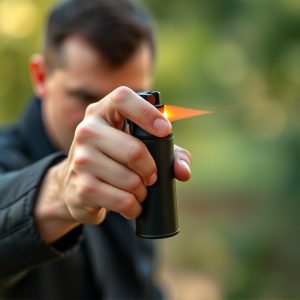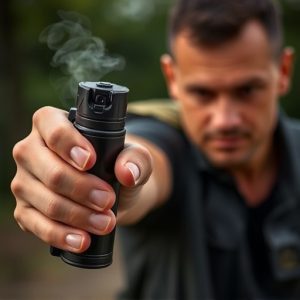Pepper Spray Storage & Maintenance: A Comprehensive Guide for Law Enforcement
Law enforcement relies on pepper spray as a critical tool for public safety, utilizing various types…….
Law enforcement relies on pepper spray as a critical tool for public safety, utilizing various types that emit oleoresin capsicum (OC) to temporarily incapacitate individuals. Effective deployment depends on proper storage and maintenance as outlined in the Pepper Spray Storage and Maintenance Guide. This guide emphasizes cool, dry conditions, secure storage, regular inspections, potency testing, and record-keeping for optimal performance and longevity of equipment, ensuring officers have reliable tools during critical situations while mitigating legal and operational risks.
“In the realm of law enforcement, pepper spray equipment is an indispensable tool for maintaining public safety. This comprehensive guide, ‘Pepper Spray Storage and Maintenance Guide,’ delves into the essential aspects of managing these devices. From understanding various types and their purposes to mastering safe storage practices, regular maintenance checks, troubleshooting common issues, and ensuring regulatory compliance, this article equips officers with vital knowledge. By adhering to best practices, law enforcement can maximize the lifespan and effectiveness of pepper spray equipment, ultimately enhancing operational efficiency.”
- Understanding Pepper Spray Equipment: Types and Purpose
- Safe Storage Practices for Optimal Lifespan
- Regular Maintenance Checklist for Law Enforcement Officers
- Common Issues and Troubleshooting Tips
- Ensuring Compliance with Regulatory Standards
Understanding Pepper Spray Equipment: Types and Purpose
Pepper spray equipment is a critical component in law enforcement strategies, designed to incapacitate individuals while ensuring officer safety. Understanding the different types and their purposes is essential for any law enforcement agency following a Pepper Spray Storage and Maintenance Guide. These devices typically use oleoresin capsicum (OC), a natural compound derived from chili peppers, which causes irritation and temporary blindness when sprayed onto an individual’s face and eyes.
The most common types include hand-held aerosol cans, similar to those used by the public for self-defense, and specialized equipment like ballistik or impact-activated devices designed to be deployed in more dynamic situations. Proper storage and maintenance, detailed in a comprehensive Pepper Spray Storage and Maintenance Guide, are vital to ensure these tools remain effective and safe when needed. This includes regular inspection, proper temperature control, and adherence to manufacturer guidelines for longevity and optimal performance.
Safe Storage Practices for Optimal Lifespan
Proper storage is key to maintaining pepper spray equipment for maximum effectiveness and lifespan. It’s crucial to store the spray in a cool, dry place away from direct sunlight or extreme temperatures. Humidity can also be detrimental; therefore, ensure the area has good ventilation. Keep it out of reach of children and unauthorized personnel, using secure containers with child-proof locks if necessary.
A detailed Pepper Spray Storage and Maintenance Guide should include regular inspection to check for any signs of damage, corrosion, or leakage. It’s recommended to test the spray periodically to ensure its potency and functionality. Additionally, keep records of maintenance activities and expiration dates to stay organized and prepared for future use.
Regular Maintenance Checklist for Law Enforcement Officers
Law enforcement officers rely on pepper spray as a crucial non-lethal force option, making regular maintenance and proper storage essential for its effectiveness. A detailed Pepper Spray Storage and Maintenance Guide should be implemented to ensure optimal performance. This guide includes a comprehensive checklist that covers several critical areas.
Firstly, officers must inspect the spray canister regularly, checking for any signs of damage or corrosion. The date of purchase and expected expiration date are vital details to track, as pepper spray potency diminishes over time. Additionally, storing the spray in a cool, dry place, away from direct sunlight, is paramount to preserving its integrity. Officers should also ensure that replacement parts, such as triggers and nozzles, are readily available and compatible with their equipment.
Common Issues and Troubleshooting Tips
Many law enforcement officers face common issues with their pepper spray equipment, often stemming from inadequate storage and maintenance practices. One of the primary challenges is ensuring proper Pepper Spray Storage and Maintenance Guide. Failure to store the spray in a cool, dry place can lead to reduced effectiveness due to chemical degradation. Additionally, regular maintenance checks are crucial; this includes inspecting the spray for any signs of damage or leakage and checking the expiration date of the contents.
Troubleshooting tips include addressing issues like blocked nozzles promptly, as they may hinder deployment during critical situations. Officers should also be trained in proper usage techniques to maximize the spray’s impact while minimizing off-target effects. Regular equipment inspections and adherence to a comprehensive Pepper Spray Storage and Maintenance Guide are vital to ensure officers are equipped with reliable tools for public safety.
Ensuring Compliance with Regulatory Standards
Law enforcement agencies must adhere to strict regulatory standards regarding pepper spray equipment, as outlined in the Pepper Spray Storage and Maintenance Guide. This includes proper storage, regular inspection, and consistent maintenance routines to ensure the integrity and effectiveness of each unit. Non-compliance can lead to serious consequences, both legal and operational, endangering officer safety and the success of law enforcement missions.
Regulatory standards dictate specific requirements for securing pepper spray containers, often involving secure locked cabinets or compartments. They also establish guidelines for inventory management, including regular audits to track each unit’s location and condition. Proper maintenance involves cleaning, testing, and calibrating equipment according to manufacturer recommendations, ensuring optimal performance when needed most.
Pepper spray is a valuable tool in law enforcement, but proper storage and regular maintenance are essential to ensure its effectiveness. By following this comprehensive guide, officers can maximize the lifespan of their pepper spray equipment. From understanding the different types and safe storage practices to regular checks and troubleshooting common issues, each step contributes to ensuring the reliability of pepper spray when it matters most. Stay compliant with regulatory standards and keep yourself and your community safe.


